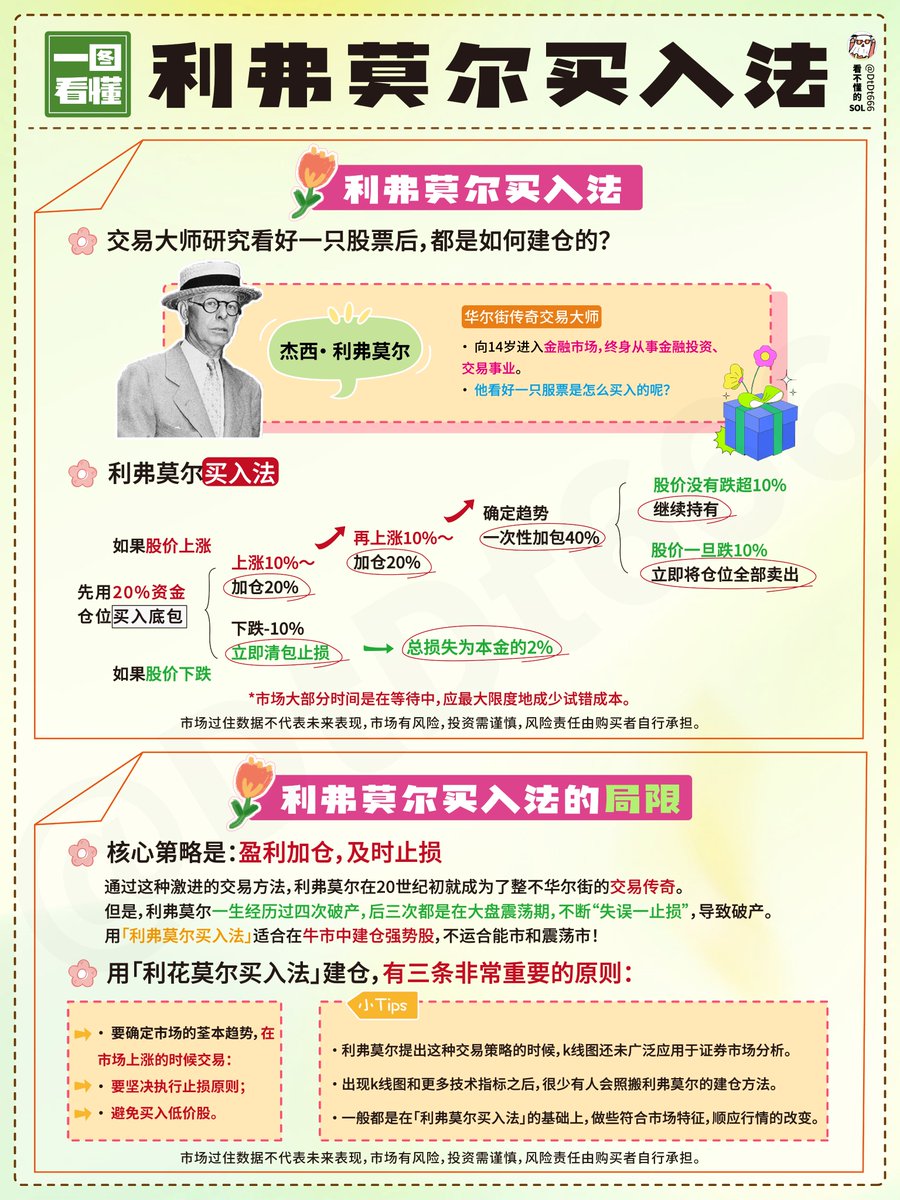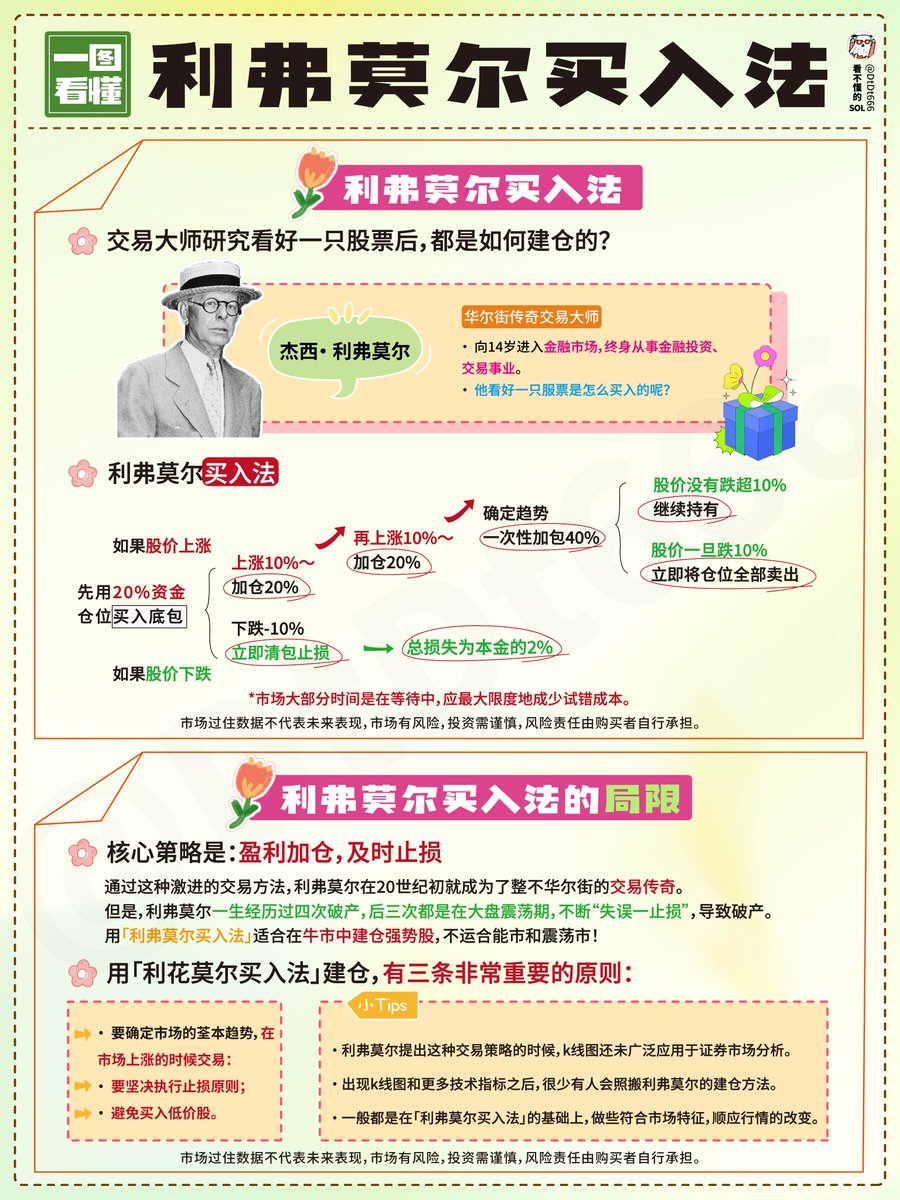Understanding the Kelly Formula in One Image: Revolutionize Your Investment Perspective
Why do top gamblers never go all in?
Retail investors typically only consider "rise" or "fall." The Kelly Formula teaches us to account for several factors: the probability of a rise, the potential upside, the probability of a fall, and the potential downside, and then calculate the position size accordingly.
First, the core of the Kelly Formula: Investing is a game of probabilities:
Don't be greedy: Even if the win rate is high, you shouldn't "go all in," as one failure could wipe you out completely.
Don't be overly conservative: If the opportunity is good, betting more appropriately can yield higher returns.
Dynamic adjustment: Adjust based on current capital; bet more when you have more money, and bet less when you have less.
Bet heavily on good opportunities, but ensure you have enough capital to weather bad luck.
The difference between buying stocks/BTC and gambling is: If you lose, you only lose a portion, not everything (unless the stock/coin price drops to zero). In this scenario, the Kelly Formula is:
f = p/l - q/g
Where:
f is the optimal proportion of investment amount (position size)
p is the probability of price increase (win rate)
q is the probability of price decrease (q=1-p)
g is the magnitude of price increase (upside potential)
l is the magnitude of price decrease (downside potential)
When someone tells you to go all in, remember to pull out the Kelly Formula and calculate the optimal position size.
The Kelly Formula acts like a "smart fund allocator," helping you decide how much capital to invest in each opportunity, maximizing long-term returns while avoiding the risk of bankruptcy.
Key Points to Note:
Dependence on accurate predictions: If you overestimate the win rate or odds, the Kelly Formula can mislead you.
Avoid extreme scenarios: For example, if the formula suggests betting over 100%, it indicates a "trap" (there's no such thing as guaranteed profit in reality).
Practical adjustments: Many people use "half-Kelly" (betting half the suggested proportion) to further reduce risk.
In summary:
The Kelly Formula teaches you—"Bet heavily on good opportunities, but ensure you have enough capital to weather bad luck."

Understand the breakthrough buying method of the king of speculation, Jesse Livermore, in one chart:
(1) First, buy 20%;
(2) If the purchase is wrong, immediately stop loss when the price drops by 10%, resulting in a loss of 2% of the total position;
(3) If the purchase is correct, immediately add 20% when the price rises by 10%;
(4) Add another 20% when the price rises by another 10%;
(5) Finally, directly add 40%;
(6) Expand the victory results and hold the position as long as the price does not drop by 10%;
(7) Once the price drops by 10%, immediately sell all positions.
The essence lies in finding high-probability opportunities to operate. Most of the time in the market is spent waiting, and the cost of trial and error should be minimized.
However, this method is suitable for building positions in strong coins/stocks during a bull market and is not suitable for volatile market conditions.
1️⃣ What is Jesse Livermore's core investment philosophy? Let me summarize briefly:
🔺 Trend is paramount: He emphasized following market trends, believing that the market has clear bull market upward trends and bear market downward trends. Investors should identify and follow these trends, avoiding counter-trend actions.
🔺 Risk control: He valued stop-loss and fund management, setting stop-loss points for each trade to prevent losses from expanding, and reducing risk through diversification and position control.
🔺 Independent thinking and patient waiting: He advocated independent market analysis, not relying on others' opinions, and patiently waiting for suitable trading opportunities, such as price breakthroughs at key resistance levels or pullbacks to support levels.
2️⃣ Let profits run
This is also one of Livermore's core investment philosophies.
Once a trade starts to generate profits, he would not rush to close the position due to short-term price fluctuations or minor pullbacks.
He believed that profits should grow as much as possible under the momentum of the trend, just like letting a galloping horse run freely on a track without obvious obstacles.
As long as the market trend has not changed, profitable positions should be held until clear reversal signals appear. This philosophy reflects his trust in trends and pursuit of long-term investment returns.
3️⃣ Trend judgment and following the trend
(a) Recognizing the big picture
Livermore believed that making big money depends on the overall market trend rather than individual stock fluctuations. He actively identified major market trends and the path of least resistance, avoiding the limitations of "bull market" and "bear market" thinking. For example, in 1907, he first shorted and then went long, and in 1929, he shorted near high prices, both resulting in substantial profits.
Following the trend: Buy during an upward trend, sell during a downward trend, and align with the market direction. When the market lacks a clear trend, choose to wait and act only when the trend becomes clear.
(b) Timing
Waiting for key points: Livermore patiently waited for critical trading points, such as when purchasing Bethlehem Steel, waiting for 6 weeks until the stock price broke through 100 points before buying.
Acting after confirming the trend: Do not enter prematurely; wait for market changes to confirm the viewpoint and then act decisively.
(c) Fund management and position control
Tentative operations: Start with small positions, such as buying 20% of the planned position. If profitable, add positions; if losses reach a certain proportion (e.g., maximum 10%), stop loss.
Avoid adding to losing positions: Do not add positions during losses to average costs, avoiding expanded losses.
Diversify investments: Do not concentrate funds in one place, reducing the risk of all-or-nothing.
(d) Strict stop-loss and take-profit
Resolute stop-loss: Set stop-loss points, such as a maximum loss of 10% per trade, and clear positions unconditionally to prevent losses from expanding.
Let profits run: When stocks rise, do not fear pullbacks; consider the reasons for the rise and avoid selling prematurely, allowing profits to continue growing.
(e) Independent thinking and contrarian thinking
Independent analysis and judgment: Do not easily believe rumors; rely on personal research for decision-making. After suffering losses from trusting others' advice, he became more independent and even used rumors in reverse.
Contrarian thinking: Question the general market view and look for trading opportunities contrary to market consensus.
(f) Managing trading emotions
Stay calm and rational, avoiding greed and fear from influencing decisions. Develop strategies before trading and execute them strictly, avoiding blind or impulsive actions.
3️⃣ Livermore's successful cases
(a) Operations during the 1907 stock market crash
- Background: In 1907, the U.S. financial market faced a severe crisis, with the stock market plummeting. The market environment was filled with panic, banks experienced runs, and many financial institutions were on the brink of collapse.
- Operation process: Livermore noticed the market's fragility and the impending collapse trend. He began shorting stocks, borrowing stocks and selling them, expecting prices to fall. As market panic spread, stock prices dropped sharply as he predicted. When the market reached a certain level near the bottom, he reversed and went long. Through this strategy of first shorting and then going long, Livermore earned millions of dollars during this stock market crisis. This demonstrated his precise market trend judgment and ability to seize opportunities for contrarian operations.
(b) Bethlehem Steel stock trading
- Background: At the time, the steel industry held significant importance in economic development, and Bethlehem Steel was a key company in the industry.
- Operation process: Livermore was very cautious in trading Bethlehem Steel stock. He waited for 6 weeks, continuously observing the stock's price trend and market sentiment. When the stock price broke through the critical level of 100 points, he saw it as a key buying signal and decisively bought in. Subsequently, with the development of the steel industry and the company's performance improvement, the stock price continued to rise. Livermore achieved substantial profits by patiently waiting for key moments and entering after the trend was established.
(c) Shorting during the 1929 U.S. stock market crash
- Background: In the 1920s, the U.S. stock market experienced a massive bubble, with apparent economic prosperity hiding underlying crises. Stock prices were excessively overvalued, and market sentiment was extremely optimistic.
- Operation process: With years of experience and keen insight, Livermore detected the impending burst of the market bubble. Near the peak of the stock market in 1929, he began large-scale shorting of stocks. As the market collapsed and stock prices plummeted, he earned nearly $100 million in profits. This operation is considered a classic in his trading career, showcasing his exceptional skills in trend judgment and decisive action, as well as his deep understanding of the overall market environment.
At his peak, Livermore owned the most beautiful office in New York, located at 730 Fifth Avenue, complete with a private elevator. Every year before New Year's, Livermore would lock himself in his private vault for three days, sitting among millions of dollars in cash, carefully reviewing the reasons for past trading failures.
His life was full of ups and downs, going bankrupt four times but always managing to make a comeback, earning him the title of a Wall Street legend. In over 100 years of stock market history, Livermore traded for nearly half a century.
On November 28, 1940, Jesse Livermore, the legendary figure of Wall Street, arrived at the Sherry-Netherland Hotel in New York to identify his father's body. After looking at his father's corpse for several minutes, he broke down and shot himself in the bathroom, ending his life at the age of 63.
Before his death, he left a note with scrawled handwriting: "My life is a failure." Opinions about his life vary, but one description is most fitting: "A lifetime of greatness, a body full of madness." — "Reminiscences of a Stock Operator"
Let us all be inspired!

511.75K
931
The content on this page is provided by third parties. Unless otherwise stated, OKX is not the author of the cited article(s) and does not claim any copyright in the materials. The content is provided for informational purposes only and does not represent the views of OKX. It is not intended to be an endorsement of any kind and should not be considered investment advice or a solicitation to buy or sell digital assets. To the extent generative AI is utilized to provide summaries or other information, such AI generated content may be inaccurate or inconsistent. Please read the linked article for more details and information. OKX is not responsible for content hosted on third party sites. Digital asset holdings, including stablecoins and NFTs, involve a high degree of risk and can fluctuate greatly. You should carefully consider whether trading or holding digital assets is suitable for you in light of your financial condition.

